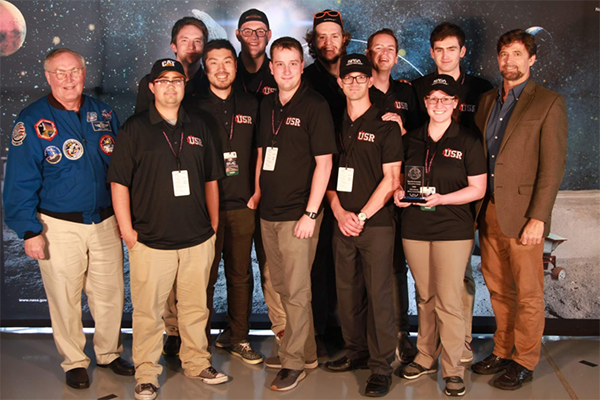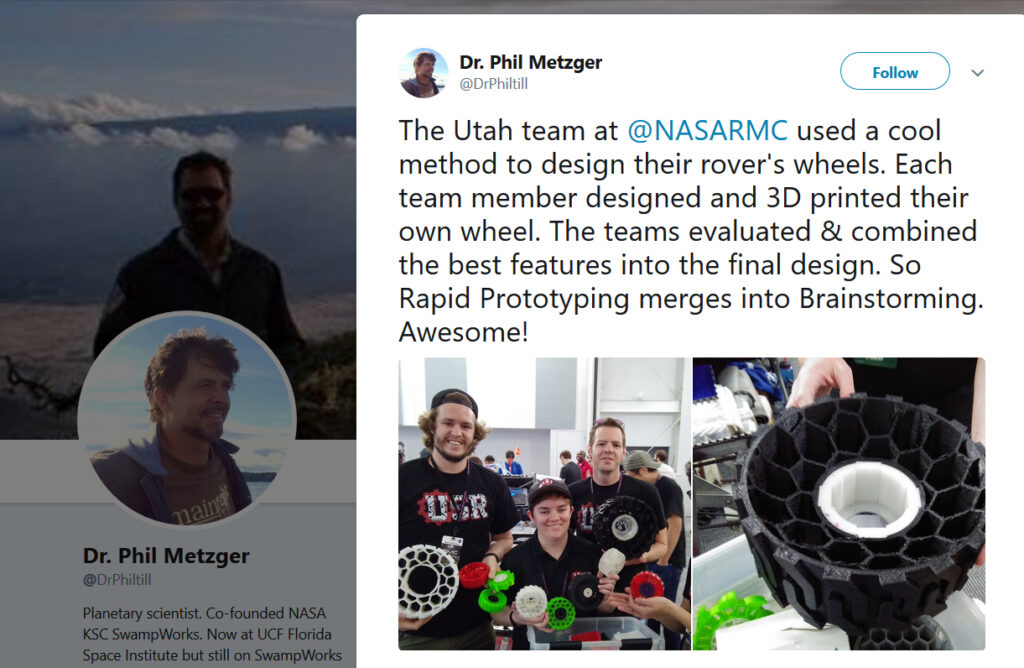The University of Utah’s Utah Student Robotics (USR) team competed for the fourth time May 14-18, at NASA’s Kennedy Space Center for the NASA RMC (Robotic Mining Challenge) winning the SSERVI (Solar System Exploration Research Virtual Institute) Regolith Mechanics Award, and taking 2nd in the Presentation and Demonstration Award. Impressively they accomplished this with a completely redesigned robot. The redesign was in response to the competition rule changes. Those changes proved challenging and were significant as they had to move from a surface frontloader to a digging conveyor system as well as reach the icy regolith within the competition run-time.
NASA RMC is an annual competition held at Kennedy Space Center that tasks over 50 collegiate teams with building a mining robot and mining gravel from beneath the surface of a simulated Martian terrain. The Competition challenge is to mine the precious icy regolith (gravel). This water ice will provide oxygen, water and fuel for future off-world colonists. Robots must navigate the difficult and foreign terrain utilizing autonomy, then reaching a dig depth of 12 inches to collect the buried icy regolith and return to deposit material in the collection bin within a 10 minute round.
Our USR team was composed of about two dozen students from the departments of mechanical engineering, electrical and computer engineering, computer science and engineering, and geology. Eleven students from the U made the journey to Cape Canaveral, Florida. This year’s competition went up against an accelerated timetable due to weather delays.
Team member Dorothy Van Komen (MEEN BS 2018 – pictured above front row of center image) said, “We had a great time working together to solve issues and malfunctions as they arose, and getting to know all the fellow teams and volunteers. It was incredible being at NASA and getting to meet other wonderful university students and to hear nice feedback from NASA engineers. Everyone had a great attitude even in the face of a failing robot. We never stopped trying to help fellow teammates and the other teams.”
“Although the robot didn’t manage to have a qualifying run,” adds Van Komen, “few schools did between the weather delays and the rule changes. We are proud of what we were able to accomplish this past year and proud of the design and friendly legacy we are passing on to next year’s team. At the competition our team and our ideas performed well with the judges, winning the SSERVI (Solar System Exploration Research Virtual Institute) Regolith Mechanics Award and taking 2nd in the Presentation and Demonstration Award. Judges were especially interested in our utilization of advanced 3D printing, which included rubber airless tires, nylon digging buckets, and titanium sprocket hubs.”

“On behalf of @NASA SSERVI, we awarded the Regolith Mechanics Innovation Award to the University of Utah. They developed a lunar soil simulant and used it to fine-tune a digging system that acoustically vibrates dust so it flows away from the ore. Super cool stuff! @NASARMC” Quote from planetary scientist and co-founder of NASA swampworks Dr. Phil Metzger https://t.co/008m7vH2do
| Advanced Placement Test | Score | UofU Course Waived | Course Placement |
|---|---|---|---|
| Calculus AB | 3 | none | MATH 1210 or 1310 |
| 4 | MATH 1210 | MATH 1220 or 1311 | |
| 5 | MATH 1210 | MATH 1220 or 1311 | |
| Calculus BC | 3 | MATH 1210 | MATH 1220 or 1311 |
| 4 | MATH 1210 and 1220 | MATH 1320 or 1321 or 2210 | |
| 5 | MATH 1210 and 1220 | MATH 1321 or 2210 | |
| Physics C: Mechanics | 4 | PHYS 2210 | PHYS 2220 |
| 5 | PHYS 2210 | PHYS 2220 | |
| Physics C: Elect. & Mag. | 4 | PHYS 2220 | No further Physics required if credit was also received for PHYS 2210 |
| 5 | PHYS 2220 | No further Physics required if credit was also received for PHYS 2210 | |
| Chemistry | 4 | CHEM 1210 | No further Chemistry required if lab notebook is also presented for CHEM 1215 credit |
| 5 | CHEM 1210 | No further Chemistry required if lab notebook is also presented for CHEM 1215 credit |
